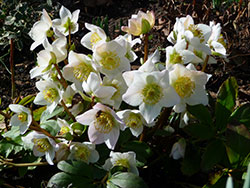Margaret Wolf
Colorado State University Extension Master Gardener in Larimer County
August 22, 2015

Hellebores (sometimes known as the Christmas or lenten rose) are evergreen members of the buttercup family. These plants flower in late winter or early spring and are hardy in Zones 4 to 9. The native range of hellebores is Greece, Turkey and Russia. Hybridizing has increased the flower color palette, which includes white, green, pink, maroon or spotted flowers. Most varieties will re-seed readily. Because the plants are already hybrids new color flowers will appear as the plants reproduce themselves.
Hellebore plants are 1 1/2 to 2 feet tall so the flowers are close to the ground drooping down on a 45 degree angle for an extended bloom cycle. Flowers droop as a survival mechanism to snow, sleet and rain. The weather in winter and early spring is not conducive to pollination by insects. Some early bees or flower flies take advantage of the few plants that are blooming. Once the flowers are pollinated the plant will produce seed pods that swell rapidly as the weather warms and pop open spilling plump black seeds all over the ground. These seeds contain immature embryos that mature in the moist warm leaf litter under the parent plant. As the weather turns colder the seeds will germinate, usually late December or early January. Two to four years later the first flowers will appear.
Hellebores are evergreen perennials which prefer partial to full shade. The foliage is attractive with large shiny dark green leaves. Plant hellebores in well-drained soil enriched with plenty of organic matter. Plants prefer filtered sunlight. Planting them under deciduous shade trees where they get some morning sun will provide shade during the hot summer months. Hellebores are heavy feeders that need most of their nutrients in the spring and summer. Timed-released fertilizers applied in the spring and late summer will carry the plants into full bloom.
Most species bloom somewhere between December to April and will stay in bloom for a month or longer. The foliage remains attractive into summer, so mass plantings are appropriate. These plants are ideal for woodland gardens. Rich moist soil is desirable. Hellebores have relatively few pest or disease problems. Aphids can be troublesome but are not considered a major problem. Poor air circulation and damp conditions can lead to bouts with Botrytis, a common grey mold fungus which can be easily controlled by proper spacing. Once established, hellebores are extremely cold hardy and very drought tolerant.
The best way to enjoy these flower blooms is to cut them with about an inch of stem and float them in a shallow bowl of water. They can last for weeks as they slowly fade into completely different colors.
Some varieties of helllebores:
H. argutifolius (Corsican Hellebore) is a robust plant, either erect or sprawling, 2-3’ tall and wide with blue green sharply divided leaves and pale green cup shaped flowers. Leafy stems carry clusters of 2” pale green flowers from winter to spring. Best varieties are ‘Janet Starnes’ or ‘Pacific Frost’.
H. niger (Christmas Rose) is a traditional cottage garden plant. This elegant 1’ tall and wide plant, blooms from Christmas to spring. Dark green leaves are divided into seven to nine lobes. White clusters of delicate flowers turn pinkish with age. New double pink hybrids are now available. These plants need more shade than other hellebores. This is probably the cold hardiest of all the species. The most well known variety is ‘Potter’s Wheel’ an exceptionally large flowering strain, with flowers up to 5”.
H. orientalis (Lenten Rose) is the most popular hellebore forming a clump 2-3’ tall and wide. Basal leaves have 5-11 sharply toothed leaves with no obvious stems. It blooms late winter to spring. Flowers are 2-4” wide and range in color from pinks, greens, creams, and purples. Many flowers are spotted with deep purple depending on the hybrid. This plant is easy to transplant and readily self sows.
The author has received training through Colorado State University Extension’s Master Gardener program and is a Master Gardener volunteer for Larimer County.
——————-
Larimer County is a county-based outreach of Colorado State University Extension providing information you can trust to deal with current issues in agriculture, horticulture, nutrition and food safety, 4-H, small acreage, money management and parenting. For more information about CSU Extension in Larimer County, call (970) 498-6000 or visit www.larimer.org/ext
——————-
Looking for additional gardening information? Check out the CSU Extension Horticulture Agent blog at www.csuhort.blogspot.com for timely updates about gardening around the state.
——————-
Visit PlantTalk Colorado ™ for fast answers to your gardening questions! www.planttalk.org PlantTalk is a cooperation between Colorado State University Extension, GreenCo and Denver Botanic Gardens.





